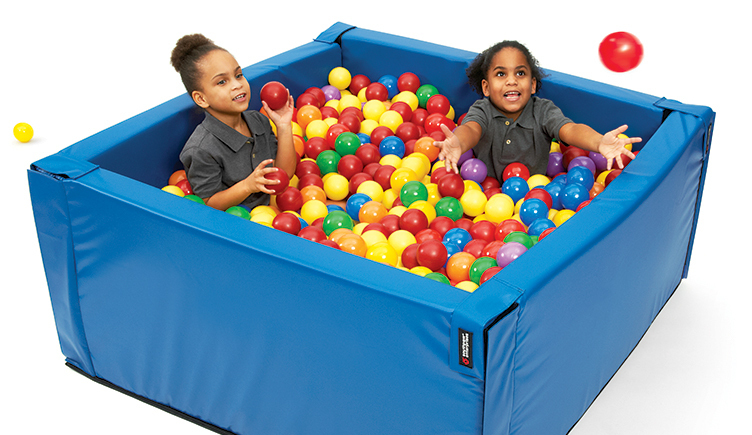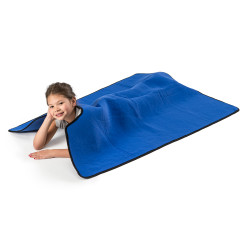Good sleep is considered one of the five pillars of health and essential for participation in all other life activities. Unfortunately, 25% of typical children and more than 50% of children with disabilities, like autism or sensory processing deficits, experience ongoing sleep problems (Galli et al., 2022). Sleep problems for the child directly impact the sleep of all family members and can lead to impaired thinking, difficulty regulating emotions and behaviors, and long-term physical and mental health problems. (Galli et al., 2022; Russell et al., 2016).
Sensory-based interventions have been shown to have a positive effect on sleep in children with sensory processing difficulties. A variety of factors can impact sleep in these children and it is important to consider interventions that address the child, their sleep environment, and the patterns and routines that support sleep for the whole family (Galli et al., 2022; Ho & Siu, 2018; Russell et al., 2016). The following sensory-based interventions have been shown to improve the time it takes to get to sleep, the total amount of sleep, or the number of sleep disruptions in children with sensory processing deficits.
Bedtime Routines
A stable bedtime routine is one of the most important factors in healthy sleep. While most people consider their bedtime routine to include the activities completed within an hour before sleep, children with sensory processing problems may need a much longer time to wind down and prepare for sleep. Families should select activities that are calming and regulating for the hours prior to bedtime. These could include warm baths, aromatherapy sprays, massage with oils, story books and audiobooks, or time in a Body Sox or Squeeze Me. Additionally, children should avoid electronic devices for several hours before bed, as the blue light emitted from TVs, phones and tablets can inhibit the body’s production of melatonin and negatively impact sleep/wake cycles (Lely et al., 2015). The use of visual schedules, timers and predictable routines can help children establish consistent bedtimes and wake times, leading to greater ease and independence with sleep preparation.
Bedding
Bedding is a key factor when making the environment inviting for sleep. While some children may use their beds as a trampoline or bouncy surface for needed sensory input, many experts agree that beds should only be used for sleep and rest. This allows the brain to associate the space with sleep (American Academy of Sleep Medicine [AASM], 2018). When selecting bedding, parents might choose memory foam rather than a coil spring mattress to discourage nighttime jumping. In contrast, it is important to provide other surfaces for bouncing, jumping and wrestling. Items like Fold & Go Trampoline or Feetballs could be used in other parts of the house to allow the child to get the necessary stimulation throughout the day and away from the bed.
Weighted blankets can improve the time it takes to get to sleep and decrease the number of sleep disruptions in children with sensory processing difficulties (Gee et al., 2018). It is important to find the correct weight that is comfortable for the child, and many experts recommend 10% of the child’s body weight (Eron et al., 2020). Southpaw offers many types of weighted blankets and weighted stuffed animals in a variety of weights and fun patterns. For those children who do not enjoy the extra heat of a weighted blanket, one might consider a weighted lap pad or a LYCRA® sleeve, like the Stretch-Eze®, placed over the mattress, that allows the child to sleep under the resistance of the sleeve without the extra heat.
Lighting and Sound
Hypersensitivity to light and sound is a hallmark of sensory processing deficits, and excess light or noise is one of the most common factors attributed to sleep disruption. Lighting intensity and color can impact the release of melatonin in the human body and alter the natural rhythms of sleep/wake cycles (Lockley et al., 2003). To promote sleep, bedroom spaces should include primary lighting (overhead or direct sunlight) and secondary (lamps/soft lighting) that can be used in tandem to create a sunrise or sunset sensation to support natural sleep rhythms. Blackout curtains or dimming light covers can be used to limit primary light sources, and Southpaw’s rope lights can be used to create a secondary light source during evenings and mornings routines. While most experts recommend complete darkness while sleeping, some children will not tolerate a dark room. Any secondary lighting used in the evening or night-lights used throughout the night should be red in color or warm in hue, since these colors have been shown to promote sleep (Lockley et al., 2003).
Sounds and noises in the bedroom can be both disturbing and comforting. It is important to consider the child’s preference for sound when creating the sleep environment. Heavy carpets or foam mats can be used as a sound buffer to keep ambient noise from interrupting sleep. Conversely, white noise, rhythmic music (like Sacred Earth Drums CD) or recorded mindfulness meditations can quiet intrusive thoughts and promote a restful state (Rusch et al., 2019). Initial evidence suggests that pillows equipped with sound, like Southpaw’s Vibro-Acoustic Pillow, can improve overall sleep performance (Wolfhope & Hudkins, 2016).
Addressing sleep problems in children with sensory processing deficits is essential for their health and the health of their families. It is important for families and professionals to work together to select interventions that meet the needs of the child and support the routines of the family. Using a multidimensional approach and including evidence-based interventions increase the chances of improving sleep in these children and positively impacting the health and well-being of their entire families.
References
American Academy of Sleep Medicine [AASM]. (2018). Cognitive Behavioral Therapy for Insomnia: CBTi . Sleep Education. http://sleepeducation.org/treatment-therapy/cognitive-behavioral-therapy
Eron, K., Kohnert, L., Watters, A., Logan, C., Weisner-Rose, M., & Mehler, P. S. (2020). Weighted blanket use: A systematic review. The American Journal of Occupational Therapy , 74(2), 7402205010p1-7402205010p14. https://doi.org/10.5014/ajot.2020.037358
Galli, J., Loi, E., Visconti, L. M., Mattei, P., Eusebi, A., Calza, S., & Fazzi, E. (2022). Sleep disturbances in children affected by Autism Spectrum Disorder. Frontiers in Psychiatry, 13, 736696. https://doi.org/10.3389/fpsyt.2022.736696
Gee, B., Romriell, G., Vandenburg, S., & Lloyd, K. (2018). Improving sleep quality among children with autism spectrum disorder and sensory overresponsivity. American Journal of Occupational Therapy, 72(4_Supplement_1), 7211520304p1-7211520304p1. https://doi.org/10.5014/ajot.2018.72S1-PO3027
Ho, E. C. M., & Siu, A. M. H. (2018). Occupational therapy practice in sleep management: A review of conceptual models and research evidence. Occupational Therapy International, 2018. https://doi.org/10.1155/2018/8637498
Lely, S. van der, Frey, S., Garbazza, C., Wirz-Justice, A., Jenni, O. G., Steiner, R., Wolf, S., Cajochen, C., Bromundt, V., & Schmidt, C. (2015). Blue blocker glasses as a countermeasure for alerting effects of evening light-emitting diode screen exposure in male teenagers. Journal of Adolescent Health , 56(1), 113–119. https://doi.org/10.1016/j.jadohealth.2014.08.002
Lockley, S. W., Brainard, G. C., & Czeisler, C. A. (2003). High sensitivity of the human circadian melatonin rhythm to resetting by short wavelength light. The Journal of Clinical Endocrinology and Metabolism, 88(9), 4502–4505. https://doi.org/10.1210/jc.2003-030570
Rusch, H. L., Rosario, M., Levison, L. M., Olivera, A., Livingston, W. S., Wu, T., & Gill, J. M. (2019). The effect of mindfulness meditation on sleep quality: A systematic review and meta-analysis of randomized controlled trials. Annals of the New York Academy of Sciences, 1445(1), 5–16. https://doi.org/10.1111/nyas.13996
Russell, M., Baldwin, C., Quan, S., McClain, D., Smith, C., & Matthews, N. (2016). Sleep problems in children with autism spectrum disorder and in their caregivers. American Journal of Occupational Therapy, 70(4_Supplement_1), 7011505108p1-7011505108p1. https://doi.org/10.5014/ajot.2016.70S1-PO1088
Wolfhope, K., & Hudkins, A. (2016). Increasing quality of sleep utilizing the ils dreampad mini in children with autism spectrum disorder. American Journal of Occupational Therapy , 70(4_Supplement_1), 7011515252p1-7011515252p1. https://doi.org/10.5014/ajot.2016.70S1-PO2023



